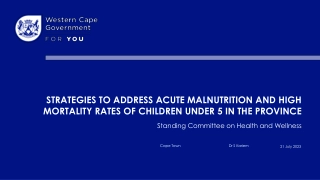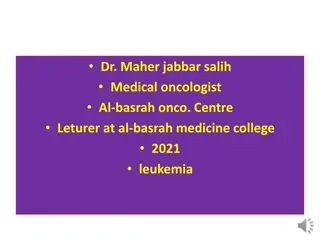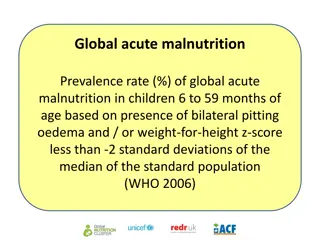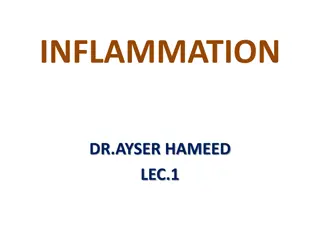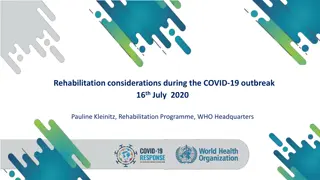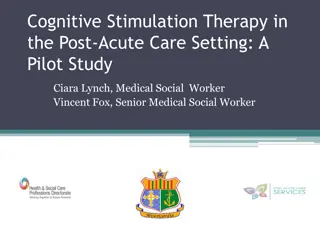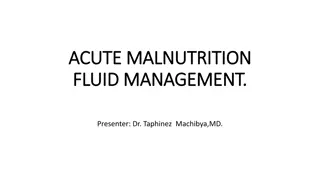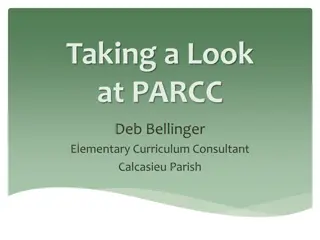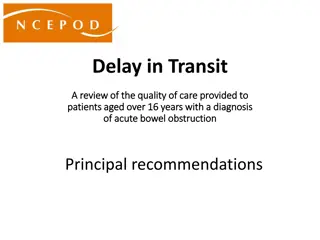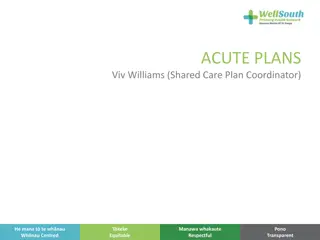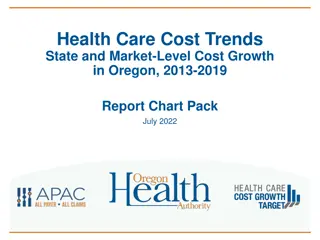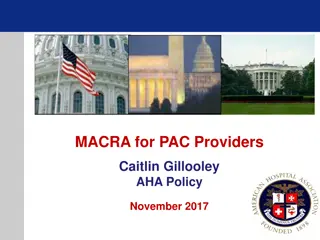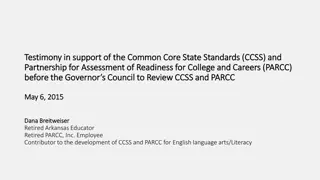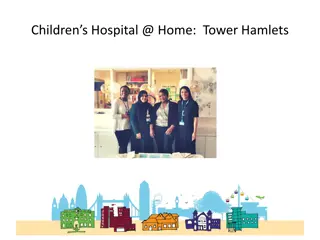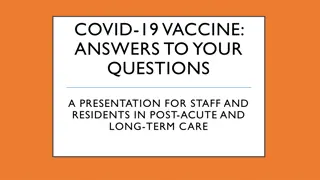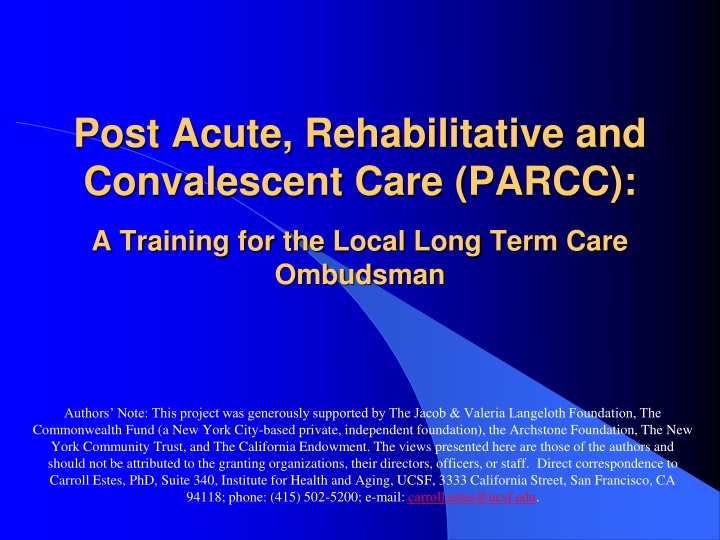
Post-Acute Care: PARCC Overview and Growth Factors
Explore the concept of Post-Acute, Rehabilitative, and Convalescent Care (PARCC), including its definition, coverage, and factors driving its growth. Learn about Medicare coverage, the impact of hospital and nursing home payment systems, and more.
Download Presentation

Please find below an Image/Link to download the presentation.
The content on the website is provided AS IS for your information and personal use only. It may not be sold, licensed, or shared on other websites without obtaining consent from the author. If you encounter any issues during the download, it is possible that the publisher has removed the file from their server.
You are allowed to download the files provided on this website for personal or commercial use, subject to the condition that they are used lawfully. All files are the property of their respective owners.
The content on the website is provided AS IS for your information and personal use only. It may not be sold, licensed, or shared on other websites without obtaining consent from the author.
E N D
Presentation Transcript
Post Acute, Rehabilitative and Convalescent Care (PARCC): A Training for the Local Long Term Care Ombudsman Authors Note: This project was generously supported by The Jacob & Valeria Langeloth Foundation, The Commonwealth Fund (a New York City-based private, independent foundation), the Archstone Foundation, The New York Community Trust, and The California Endowment. The views presented here are those of the authors and should not be attributed to the granting organizations, their directors, officers, or staff. Direct correspondence to Carroll Estes, PhD, Suite 340, Institute for Health and Aging, UCSF, 3333 California Street, San Francisco, CA 94118; phone: (415) 502-5200; e-mail: carroll.estes@ucsf.edu.
Definition of PARCC (Post-Acute, Rehabilitative, and Convalescent Care) Residents who: Are expected to stay in a LTC facility less than 100 days or within Medicare Coverage Are in need to skilled nursing care, rehabilitation, physical therapy, or occupational therapy Are well enough to leave the hospital, but still too sick to go home Sometimes referred to as: Short-stay, post-acute, rehab, skilled nursing, etc.
PARCC Coverage Who pays for PARCC? Medicare Will pay for 100 days of skilled nursing or rehabilitative care in a SNF, per spell of illness Requires a prior 3-day hospital stay Private Insurance
Growth in PARCC Why is PARCC a growing population? Hospital PPS The hospital prospective payment system (referred to as PPS ) was implemented in 1983 as an attempt to control costs PPS created incentives for hospitals to discharge patients earlier and shortened hospitals stays. (MedPAC, 2005). This, in turn, has spurred the growth of the post acute care sector. The post acute care sector has been the fastest growing category of Medicare payments in the 1990 s (Buntin et al. 2005).
Nursing Home PPS Congress implemented a PPS for nursing homes in 1998. Under the nursing home PPS, a case-mix- adjusted and wage-adjusted per diem payment is made to cover the routine, ancillary, and capital costs incurred in treating a skilled nursing facility patient covered by Medicare (MedPAC, 1999). Created incentives for nursing homes to discharge patients earlier, shorten stays, and minimize treatments/rehabilitation provided.
Why the LLTCOP? PARCC population comprises residents in Skilled Nursing facilities that the Ombudsmen visit They, like other nursing home residents may be vulnerable and mistreated.
Ombudsman Involvement with PARCC Residents- CA Estes, C. L., Goldberg, S., Lohrer, S., Nelson, M., Goldstein, C., & Hollister, B. (2005c). Post-acute, rehabilitative, and convalescent care: Pathways to effectiveness for the local long-term care ombudsman. Unpublished manuscript: Institute for Health and Aging, University of California San Francisco.
Ombudsman Involvement with PARCC Residents- NY Estes, C. L., Goldberg, S., Lohrer, S., Nelson, M., Goldstein, C., & Hollister, B. (2005c). Post-acute, rehabilitative, and convalescent care: Pathways to effectiveness for the local long-term care ombudsman. Unpublished manuscript: Institute for Health and Aging, University of California San Francisco.
How are PARCC Residents Different? Can be younger Can have higher physical or mental functioning than other residents They are expected to be discharged Their stay at a facility is short-term, small window for intervention/resolution They have different complaints and thus different needs from other residents
What are their complaints Not receiving Care Rehabilitation services not being given in a timely and appropriate manner Inappropriate transfer or discharge Being told they have plateau d Being discharged without sufficient reason Others?
What are the problems facing PARCC residents? Quality of care kind of issues. No really effective rehab, not only to improve but to maintain. Not following care plans. Confusion about Medicare, dropping people off Medicare too soon, and making people move from bed to bed. California LTCO The Facilities are not fully informing residents as to their rights that they can stay longer if needed. We need to tell facilities they need to advocate more for their residents and to let us help them advocate for the residents. California LTCO Estes, C. L., Goldberg, S., Lohrer, S., Nelson, M., Goldstein, C., & Hollister, B. (2005c). Post-acute, rehabilitative, and convalescent care: Pathways to effectiveness for the local long-term care ombudsman. Unpublished manuscript: Institute for Health and Aging, University of California San Francisco.
Ombudsman Experiences with PARCC Residents- CA Estes, C. L., Goldberg, S., Lohrer, S., Nelson, M., Goldstein, C., & Hollister, B. (2005c). Post-acute, rehabilitative, and convalescent care: Pathways to effectiveness for the local long-term care ombudsman. Unpublished manuscript: Institute for Health and Aging, University of California San Francisco.
Ombudsman Experiences with PARCC Residents- NY Estes, C. L., Goldberg, S., Lohrer, S., Nelson, M., Goldstein, C., & Hollister, B. (2005c). Post-acute, rehabilitative, and convalescent care: Pathways to effectiveness for the local long-term care ombudsman. Unpublished manuscript: Institute for Health and Aging, University of California San Francisco.
How can LLTCO Help PARCC residents? Learn more about the residents needs Encourage residents to ask for second opinions on important medical decisions Look at care plan and medical record Talk to the resident about their rights Talk to the resident about the option of appeal Help the resident file the appeal
Dimensions Related to Ombudsman Effectiveness with PARCC residents- CA Estes, C. L., Goldberg, S., Lohrer, S., Nelson, M., Goldstein, C., & Hollister, B. (2005c). Post-acute, rehabilitative, and convalescent care: Pathways to effectiveness for the local long-term care ombudsman. Unpublished manuscript: Institute for Health and Aging, University of California San Francisco.
Dimensions Related to Ombudsman Effectiveness with PARCC residents- NY Estes, C. L., Goldberg, S., Lohrer, S., Nelson, M., Goldstein, C., & Hollister, B. (2005c). Post-acute, rehabilitative, and convalescent care: Pathways to effectiveness for the local long-term care ombudsman. Unpublished manuscript: Institute for Health and Aging, University of California San Francisco.
What about systemic advocacy? Advance education (resident, community, facility, etc) about PARCC resident needs and complaints Encourage state offices to develop further training material for LLTCO, and educational materials for residents, families, and facilities Medicare PPS . Need better financing of care or monitoring of abuse/fraud Advocate for increased funding in order to better serve this population
Some Discussion Questions Is advocating for PARCC residents the LLTCOPs role? What priority does this take in your other work? Is more training needed on PARCC resident needs and ways to advocate for this population? Is more training needed on Medicare laws and regulations and residents rights under Medicare? Is training needed on Medicare Appeals?
PARCC Toolkit Resources Medicare / PARCC Factsheet Quick Screen Aid to identify coverable cases Key resources list for advocates Reading list Fax form for improved notification of PARCC resident admission LLTCO visitation cards for PARCC Resident PARCC Powerpoint Presentation
Website Resources Centers for Medicare and Medicaid Services http://www.cms.hhs.gov/ Center for Medicare Advocacy http://www.medicareadvocacy.org/ Center for Medicare Education http://www.medicareed.org/ Medicare Rights Center http://www.medicarerightscenter.org National Senior Citizen s Law Center www.nsclc.org
References Buntin, M. B., Escarce, J. J., Hoverman, C., Paddock, S. M., Totten, M. E., & Wynn, B. O. (2005). Effects of payment changes on trends in access to post acute care. RAND. Estes, C. L., Goldberg, S., Lohrer, S., Nelson, M., & Hollister, B. (2005c). Post-acute, rehabilitative, and convalescent care: Pathways to effectiveness for the local long-term care ombudsman. Unpublished manuscript: Institute for Health and Aging, University of California San Francisco. Medicare Payment Advisory Commission (MedPAC)(2005). "Medicare Post Acute Care. June 16, 2005. Testimony before the Subcommittee on Health, Committee on Ways and Means, U.S. House of Representatives. Medicare Payment Advisory Commission (MedPAC)(1999). Medicare Payment Policy: Improving the payment system for skilled nursing facilities. March 1, 1999. Testimony before Congress.
Enhancing the Performance of theLong-Term Care Ombudsman Program University of California, San Francisco Institute for Health & Aging Researchers: Carroll L. Estes, PhD, UCSF Professor and Founding Director, Institute for Health and Aging Brooke Hollister, BA, UCSF Graduate Student Research Assistant, Institute for Health and Aging Sheryl Goldberg, PhD, Specialist, Institute for Health and Aging Steven Lohrer, PhD, Specialist, Institute for Health and Aging Milena Nelson, BA, Analyst, Institute for Health and Aging Consultant: Lenore Gerard, JD, Attorney, Legal Assistance for the Elderly Advisors: Patricia Nemore, JD, Senior Policy Attorney, Center for Medicare Advocacy Inc. Sara Hunt, Consultant, NASOP, NORC Christian Reitler, Erie County, New York LLTCO Program Coordinator Benson Nadell, San Francisco County,California LLTCO Program Director Collaborators: California Long-Term Care Ombudsman Association (CLTCOA) New York State Ombudsman Association (NYSOA) In addition to the above, the research team would like to thank the State Long-Term Care Ombudsman offices of both New York andCalifornia for their cooperation throughout the project.

